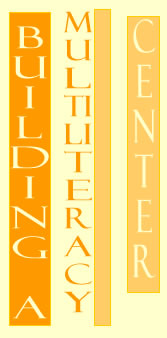

Recruiting
and Training Specialized Consultants
KHM: Can you talk more about how you trained your Multiliteracy
Consultants so that they're knowledgeable and skilled not only with sound
writing and tutoring practices but also with visual communication and
with a variety of media programs?
DS:
That's a great question because recruiting students who have the appropriate
skill sets and attracting the right students to the Multiliteracy Center
program has been one of the key challenges that I'm constantly thinking
about.
We hope that the peer consultants who work in the Multiliteracy Center
know an array of things. We hope that they are good writers and communicators.
We hope that they have excellent interpersonal skills. We hope that they
have had formal training that is based on thinking about pedagogy and
about best practices for tutoring, and we provide that through a series
of courses that we teach. But we also want them to have thought a lot
about visual and multimedia communication and graphic design. And we also
want them to have the technical skills necessary to do digital composing.
A student who has all of those skills, at least at the University of Michigan,
is pretty marketable and they can work at other positions and often get
paid more money as a web designer. You take somebody who is motivated,
who is very bright, who is a great communicator, who gets along well with
people and who can do web design, and you have got someone who is potentially
useful to a lot of units. So
it's been a real challenge to recruit these students.
We ask all of our tutors to take a two-course training sequence. The first
course focuses intensively on pedagogy and on best tutoring practices.
In the second course they tutor for credit and they meet once a week to
talk about their experiences. And if you find a student who has some design
experience, who is motivated, who is a good communicator, and is a good
writer, he or she might not have room in his or her schedule or just might
not want to take those two courses. And if you start to look at recruiting,
as we did, people who are graphic design majors, they don't want to take
those courses because they're not related to their major and they don't
count towards their program. So we have employed a number of strategies
to recruit the right kind of people to do this.
The first thing is to recruit aggressively from the people who just stumble into the traditional peer-tutoring program. In other words, we have a peer-tutoring program that a certain number of students enter into each semester. We ask each of those students, "Would you consider being involved in the Multiliteracy Center? Do you have the skills, do you have the interest, do you want to be a part of this?" And, each semester we get one or two people who do want to participate in that program. Usually they're people who don't have formal training in web design but have done it as part of a job or have done it as part of a personal hobby. And they also happen to be good writers and have good communication and interpersonal skills, as well, and are already in the process of going through the training sequence. That's one group.
We
also tried to recruit people from the School of Art and Design, graphic
design majors. Now in that case, what we had to do is offer a version
of our first training course, the pedagogy course, taught through the
School of Art and Design by an Art and Design professor, and adapt it
to meet the needs of Art and Design majors.
Top | Next
We hope that they are good writers and communicators. We hope that they have excellent interpersonal skills. We hope that they have had formal training that is based on thinking about pedagogy and about best practices for tutoring, and we provide that through a series of courses that we teach. But we also want them to have thought a lot about visual and multimedia communication and graphic design. And we also want them to have the technical skills necessary to do digital composing."